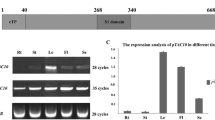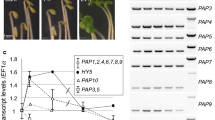Abstract
We have isolated and characterized a genomic clone encoding the 41 kDa monomer T-protein. This gene called gdcT spans approximately 3 kbp and is composed of four exons interrupted by three introns (321, 691 and 114 bp). The splice sites for donor and acceptor are in agreement with the canonical GT/AG rule. Primer extension strongly suggests the presence of two major transcription start sites. The first transcription start site around 43 bases downstream of a putative TATA box was assigned the +1 position. The second (+31) is not correlated with a putative TATA box, but revealed a pyrimidine-rich region which is very similar to the initiator element. Sequence analysis of the 5′-upstream region of the gene reveals three consensus regions found in the nuclear genes encoding the chloroplastic proteins of ribulose-1,5-bisphosphate carboxylase (rbcS) and the chlorophyll a/b-binding protein (cab) such as an AT-rich sequence localized at -539 to -530, a box II core sequence GGTTAA (-123 to -118) and between -364 and -354 a tandem GATA motif. These elements are known to be involved respectively in the regulation of light-responsiveness and cell-type specificity expression of plant genes. Gel shift assays indicate that the box II core sequence could bind protein nuclear factors similar to the trans-acting factor which interact with corresponding promoter region of rbcS gene.
Similar content being viewed by others
References
Ayer DA, Dynan WS: Simian virus 40 major late promoter: a novel tripartite structure that includes intragenic sequences. Mol Cell Biol 8: 2021–2033 (1988).
Bourguignon J, Macherel D, Neuburger M, Douce R: Isolation, characterization, and sequence analysis of a cDNA clone encoding L-protein, the dihydrolipoamide dehydrogenase component of the glycine cleavage system from pea-leaf mitochondria. Eur J Biochem 204: 865–873 (1992).
Bourguignon J, Neuburger M, Douce R: Resolution and characterisation of the glycinecleavage reaction in pea leaf mitochondria. Biochem J 255: 169–178 (1988).
Bourguignon J, Vauclare P, Merand V, Forest E, Neuburger M, Douce R: Glycine decarboxylase complex from higher plants: molecular cloning, tissue distribution and mass spectrometry analyses of the T protein. Eur J Biochem 217: 377–386 (1993).
Breathnach R, Benoist C, O Hare K, Gannon F, Chambon P: Ovalbumin gene: evidence for a leader sequence in mRNA and DNA sequemces at the exonintron bounderies. Proc Natl Acad Sci USA 75: 4853–4857 (1978).
Breathnach R, Chambon P: Organization and expression of eucaryotic split genes coding for proteins. Annu Rev Biochem 50:, 349–383 (1981).
Bucher P: Weight matrix descriptions of four eucaryotic RNA polymerase II promoter elements derived from 502 unrelated promoter sequences. J Mol Cell Biol 212: 563–578 (1990).
Castresana C, Garcia-Luque I, Alonso E, Malik VS, Cashmore AR: Both positive and negative elements mediate expression of a photoregulated CAB gene from Nicotiana plumbaginifolia. EMBO J 7: 1929–1936 (1988).
Castresana C, Staneloni R, Malik VS, Cashmore AR: Molecular characterization of two clusters of genes encoding the type I CAB polypeptides of PSII in Nicotiana plumbaginifolia. Plant Mol Biol 10: 117–126 (1987).
Coruzzi G, Broglie R, Edwards C, Chua N-H: Tissue-specific and light-regulated expression of a pea nuclear gene encoding the small subunit of ribulose-1,5-bisphosphate carboxylase. EMBO J 3:1671–1679 (1984).
Datta N, Cashmore AR: Binding of a pea nuclear protein to promoters of certain photo-regulated genes is modulated by phosphorylation. Plant Cell 1: 1069–1077 (1989).
Day DA, Neuburger M, Douce R: Biochemical characterization of chlorophyll-free mitochondria from pea leaves. Aust J Plant Physiol 12: 219–228 (1985).
Douce R, Bourguignon J, Macherel D, Neuburger M: The glycine decarboxylase system in higher plant mitochondria: structure, function and biogenesis. Biochem Soc Trans 22: 184–188 (1994).
Fluhr R, Moses P, Morelli G, Coruzzi G, Chua N-H: Expression dynamics of the pea rbcS multigene family and organ distribution of the transcripts. EMBO J 5: 2063–2071 (1986).
Gidoni D, Brosio P, Bond-Nutter D, Bedbrook J, Dunsmuir P: Novel cis-acting elements in petunia cab gene promoters. Mol Gen Genet 215: 337–344 (1989).
Green PJ, Kay SA, Chua N-H: Sequence-specific interactions of pea nuclear factor with light-responsive elements upstream of the rbcS-3A gene. EMBO J 6: 2543–2549 (1987).
Green PJ, Yong MH, Cuozzo M, Kano-Murakami Y, Silverstein P, Chua N-H: Binding site requirements for pea nuclear protein factor GT1 correlate with sequences required for light-dependent transcriptional activation of the rbcS-3A gene. EMBO J 7: 4035–4044 (1988).
Hayasaka K, Nanao K, Takada K, Okamura-Ikeda K, Motokawa Y: Isolation and sequence determination of cDNA encoding human T-protein of the glycine cleavage system. Biochem Biophys Res Commun 192: 766–771 (1993).
Herrera-Estrella L, van den Broeck G, Maenhaut R, van Montagu M, Schell J, Timko M, Cashmore A: Light-inducible and chloroplast-associated expression of a chimaeric gene introduced into Nicotiana tabacum using a Ti plasmid vector. Nature 310: 115–120 (1984).
Husic DW, Husic HD, Tolbert NE: The oxidative photosynthetic carbon cycle or C2 cycle. Crit Rev Plant Sci 5: 45–100 (1987).
Kikuchi G, Hiraga K: The mitochondrial glycine cleavage system. Mol Cell Biochem 45: 137–149 (1982).
Kim Y, Oliver DJ: Molecular cloning, transcriptional characterization, and sequencing of the cDNA encoding the H-protein of the mitochondrial glycine decarboxylase complex in peas. J Biol Chem 265: 848–853 (1990).
Klein SM, Sagers RD: Glycine metabolism. II. Kinetic and optical studies on the glycine decarboxylase system from Peptococcus glycinophilus. J Biol Chem 241: 206–209 (1966).
Kochi H, Kikuchi G: Reaction of glycine synthesis and glycine cleavage catalysed by extracts of Arthrobacter globiformis. Arch Biochem Biophys 132: 359–369 (1969).
Kopriva S, Turner SR, Rawsthorne S, Bauwe H: T-protein of the glycine decarboxylase multienzyme complex: evidence for partial similarity to formyltetrahydrofolate synthase. Plant Mol Biol 27: 1215–1220 (1995).
Lam E, Chua NH: GT-1 binding site confers light-responsive expression in transgenic tobacco. Science 248: 471–474 (1990).
Lorimer GH, Andrews TJ: The C2 chemo-and photo-respiratory carbon oxydation cycle. In: Hatch MD, Boardman NK (eds) The biochemistry of Plants, vol. 8. Photosynthesis, pp. 329–374. Academic Press, New York (1981).
Lugert T, Werr W: A novel DNA binding domain in the Shrunken initiatorbinding protein (IBP1). Plant Mol Biol 25: 493–506 (1994).
Lütcke HA, Chow KC, Mickel FS, Moss KA, Kern HF, Scheele GA: Selection of AUG initiation codons differs in plants and animals. EMBO J 6: 43–48 (1987).
Maas C, Schaal S, Weer W: Afeedback control element near the transcription start site of the maize Shrunken gene determines promoter activity. EMBO J 9: 3447–3452 (1990).
Macherel D, Bourguignon J, Douce R: Cloning of the gene (gdcH) encoding Hprotein, a component of the glycine decarboxylase complex of pea (Pisum sativum L.). Biochem J 286: 627–630 (1992).
Macherel D, Lebrun M, Gagnon J, Neuburger M, Douce R: Primary structure and expression of H-protein, a component of the glycine cleavage system of pea leaf mitochondria. Biochem J 268: 783–789 (1990).
Neuburger M, Bourguignon J, Douce R: Isolation of a large complex from the matrix of pea leaf mitochondria involved in the rapid transformation of glycine into serine. FEBS Lett 207: 18–22 (1986).
Neuburger M, Douce R: Oxydation du malate, du NADH et de la glycine par les mitochondries de plantes en C3 et C4. C R Hebd Séanc Acad Sci Ser 285: 881–884 (1977).
Odell JT, Nagy F, Chua NH: Identification of DNA sequences required for activity of the cauliflower mosaic virus 35S promoter. Nature 313: 810–812 (1985).
Okamura-Ikeda K, Fujiwara K, Yamamoto M, Hiraga K, Motokawa Y: Isolation and sequence determination of cDNA encodingTprotein of the glycine cleavage system. J Biol Chem 266: 4917–4921 (1991).
Okamura-Ikeda K, Ohmura Y, Fujiwara K, Motokawa Y: Cloning a dinucleotide sequence of the gcv operon encoding the Escherichia coli glycine-cleavage system. Eur J Biochem 216: 539–548 (1993).
Oliver DJ, Neuburger M, Bourguignon J, Douce R: Glycine metabolism by plant mitochondria. Plant Physiol 94: 833–839 (1990).
Pichersky E, Bernatzky R, Tanksley SD, Breidenbach RB, Kausch AP, Cashmore AR: Molecular characterization and genetic mapping of two clusters of genes encoding chlorophyll a/bbinding proteins in Lycopersicon esculentum (tomato). Gene 40: 247–258 (1985).
Sanger F, Nicklen S, Coulson AR: DNAsequencing with chainterminating inhibitors. Proc Natl Acad Sci USA 74: 5463–5466 (1977).
Smale ST, Baltimore D: The initiator as a transcription control element. Cell 57: 103–113 (1989).
Smale ST, Schmidt MC, Berk AJ, Baltimore D: Transcriptional activation by SP1 as directed through TATA or initiator: spe318 cific requirement for mammalian transcription factor IID. Proc Natl Acad Sci USA 87: 4509–4513 (1990).
Srinivasan R, Berndt WA, Oliver DJ: Coordinated expression of photosynthetic and photorespiratory genes. In: Brennicke A, Kuck U (eds) Plant Mitochondria, pp. 160–169. VCH, Weinheim (1993). (1993).
Srinivasan R, Kraus C, Oliver DJ: Developmental expression of the glycine decarboxylase multienzyme complex in greening pea leaves. In: Lambers H, van der Plas LHW (eds) Molecular, Biochemical, and Physiological Aspects of plant Respiration, pp. 323–334. SPB Academic, The Hague (1992).
Srinivasan R, Oliver DJ: Light-dependent and tissuespecific expression of the Hprotein of the glycine decarboxylase complex. Plant Physiol 109: 161–168 (1995).
Turner SR, Hellen R, Ireland R, Ellis N, Rawsthorne S: The organisation and expression of the gene encoding the mitochondrial glycine decarboxylase complex and serine hydroxymethyltransferase in pea (Pisumsativum). Mol Gen Genet 236: 402–408 (1993).
Turner SR, Ireland R, Rawsthorne S: Cloning and characterization of the P subunit of glycine decarboxylase from pea (Pisum sativum). J Biol Chem 267: 5355–5360 (1992).
Turner S, Ireland R, Rawsthorne S: Purification and primary amino acid sequence of the L subunit of glycine decarboxylase. Evidence for a single lipoamide dehydrogenase in plant mitochondria. J Biol Chem 267: 7745–7750 (1992).
Ueda T, Pichersky E, Malik VS, Cashmore AR: Level of expression of the tomato rbcS-3A gene is modulated by a far upstream promoter element in a developmentally regulated manner. Plant Cell 1: 217–227 (1989).
Vauclare P, Diallo N, Bourguignon J, Macherel D, Douce R: Regulation of the expression of the glycine decarboxylase complex during pea leaf development. Plant Physiol 112: 1523–1530 (1996).
Walker JL, Oliver DJ: Glycine decarboxylase multienzyme complex: purification and partial characterization from pea leaf mitochondria. J Biol Chem 261: 2214–2221 (1986).
Walker JL, Oliver DJ: Lightinduced increases in the glycine decarboxylase multienzyme complex from pea leaf mitochondria. Arch Biochem Biophys 248: 626–638 (1986).
Zutter M, Santoro SA, Audrey SP, Tsung YL, Gafford A: The human _2 integrin gene promoter. J Biol Chem 269: 463–469 (1994).
Author information
Authors and Affiliations
Rights and permissions
About this article
Cite this article
Vauclare, P., Macherel, D., Douce, R. et al. The gene encoding T protein of the glycine decarboxylase complex involved in the mitochondrial step of the photorespiratory pathway in plants exhibits features of light-induced genes. Plant Mol Biol 37, 309–318 (1998). https://doi.org/10.1023/A:1005954200042
Issue Date:
DOI: https://doi.org/10.1023/A:1005954200042




